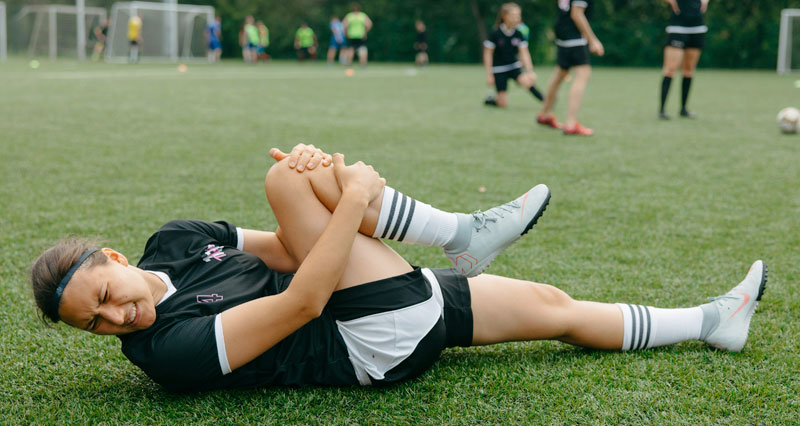When it comes to sports injuries, there are some obvious differences between men and women. Here we explain our top five most common sports injuries for women and why they affect women more than men. We also look at what you can do to try to prevent them.
1. Anterior Cruciate Ligament (ACL) Injury
An ACL sprain is a tear in the anterior cruciate ligament in the middle of the knee joint. This injury is more prevalent in women due to anatomical differences. Women have wider hips, resulting in different knee biomechanics. The Q angle (quadriceps femoris angle) between the thigh bone (femur) and the shin bone (tibia) is typically up to 5 degrees higher in women. This increased angle can lead to poor knee control and a higher risk of valgus (sideways forces) on the knee, especially when landing from a jump or turning.
Prevention Tips:
- Proprioception Exercises: Improve leg coordination by doing exercises such as the single leg balance. Stand on one leg and time how long you can balance. Make it more challenging by closing your eyes or using a wobble balance board or cushion.
- Strengthening Exercises: Focus on strengthening the quadriceps muscles, particularly the Vastus Medialis Oblique (VMO). Ensure hamstring and quadriceps muscles are well balanced in terms of strength.
2. Anterior Knee Pain
Anterior knee pain is felt around the front of the knee and often under the kneecap. It’s common in sporty or active girls and is usually linked to changes in leg biomechanics and reduced quadriceps strength, again due to an increased Q-angle. Weak gluteal (buttock) muscles, which help turn the hip and knee outwards, can also contribute by causing the knee and foot to turn inwards, increasing the Q-angle further.
Prevention Tips:
- Strengthening Exercises: Improve the strength of both the gluteal and quadriceps muscles. Consider incorporating a 4-minute glute muscle strengthening challenge into your routine.
3. Stress Fractures in the Lower Leg
Stress fractures are fine hairline cracks or fractures in the bone, often occurring in the foot and lower leg. These are caused by overuse and repetitive stress. Female athletes, particularly those experiencing the ‘female triad’ (poor nutrition, lack of menstrual periods, and reduced bone density), are more prone to stress fractures in the shin bone (tibia) and foot bones (metatarsals).
Prevention Tips:
- Healthy Diet: Maintain a balanced diet appropriate for your activity level.
- Professional Advice: Consult your GP to address symptoms of the female triad and receive necessary treatment and advice.
4. Ankle Sprains
Ankle sprains involve tears to the ligaments, usually on the outside of the ankle. These injuries are common in both men and women but are especially prevalent in women. Potential causes include poor core control from weak abdominal and hip muscles, and imbalances in leg muscles, which increase the risk of injury when running or changing direction.
Prevention Tips:
- Strength and Balance Exercises: Improve overall lower leg strength and proprioception with exercises like single leg balance drills. Test how long you can stand on one leg with your eyes closed and aim to increase the time daily.
5. Plantar Fasciitis
Plantar fasciitis is a common cause of heel pain, resulting from inflammation or injury to the tissues in the sole of the foot. In women, this often occurs due to frequently changing footwear, such as alternating between high heels and flats. The plantar fascia supports the long arch of the foot, and changing shoes can stress this tissue.
Prevention Tips:
- Consistent Footwear: Avoid frequent changes between very flat or high-heeled shoes. Opt for trainers that provide cushioning and support the arches.
- Treatment Options: If you already have plantar fasciitis, consider stretching, taping, night splints, orthotic shoe insoles, and other remedies to alleviate pain and support recovery.
By understanding these common sports injuries and taking preventive measures, women can reduce their risk of injury and maintain their athletic performance.

